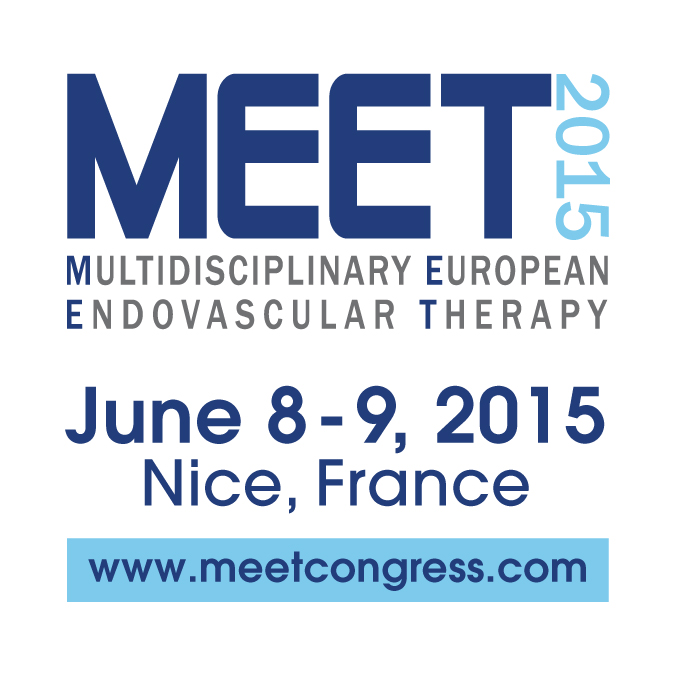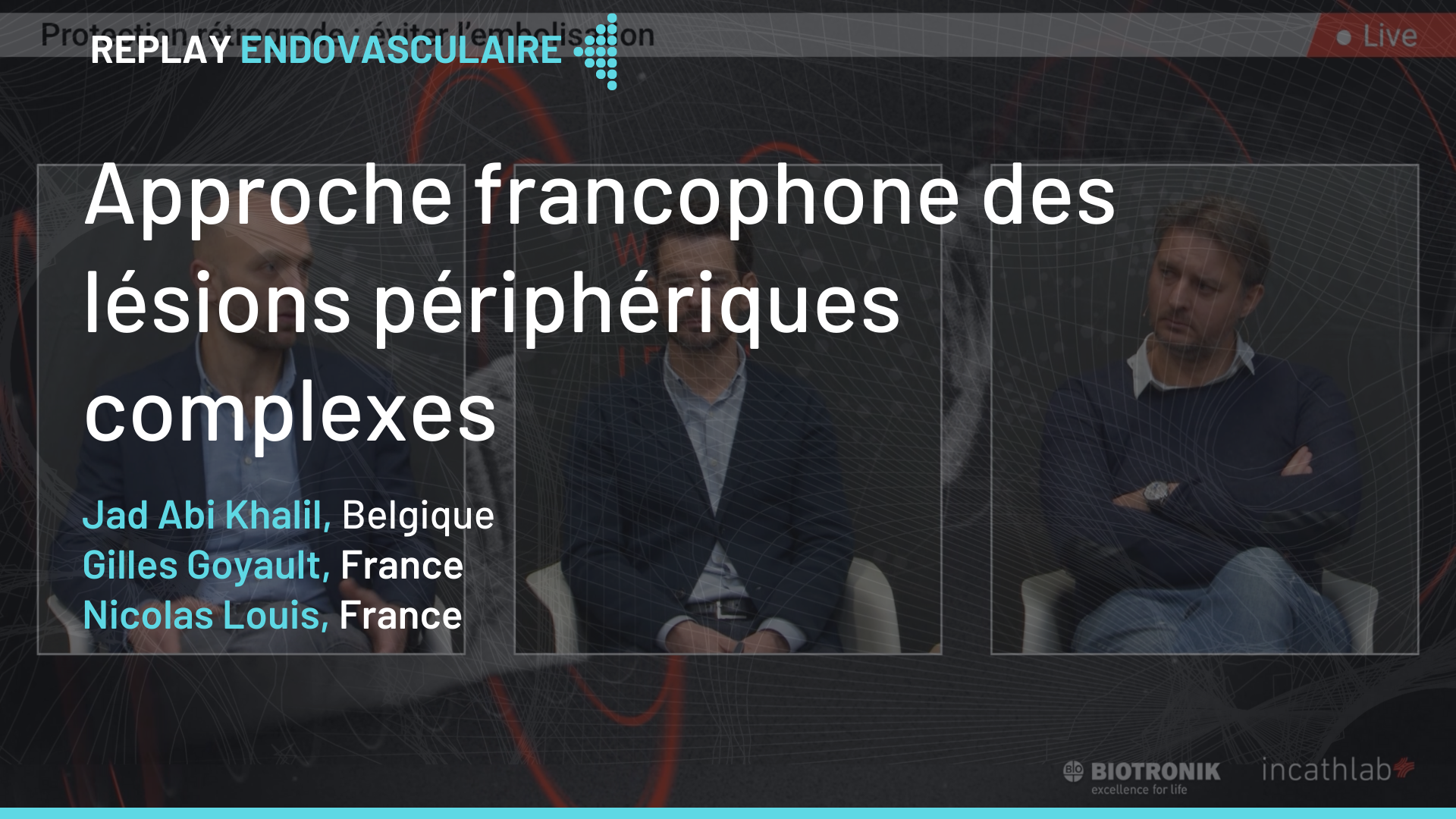×
Il semble que vous utilisiez une version obsolète de internet explorer. Internet explorer n'est plus supporté par Microsoft depuis fin 2015. Nous vous invitons à utiliser un navigateur plus récent tel que Firefox, Google Chrome ou Microsoft Edge.

Devenez membre d'Incathlab et bénéficiez d'un accès complet !
Vous devez être membre pour accéder aux vidéos Incathlab sans limitation. Inscrivez vous gratuitement en moins d'une minute et accédez à tous les services Incathlab ! Vous avez aussi la possibilité de vous connecter directement avec votre compte facebook ou twitter en cliquant sur login en haut à droite du site.
Inscription Connexion
Inscription Connexion
15038 vues

PROGRAM
Monday June 8
8.35 BTK strategies and best options |
||
| Moderators | R. Ferraresi, A. Sauguet, E. Ducasse | |
| State of the art of BTK-CLI treatment | ||
| 08.35 |
Arterial status, angiosome, arterial calcifications, is it possible to plan treatment at BTK level? |
M. Gargiulo |
| 08.43 | Big vessel versus small vessel disease: what is the true cause of critical limb ischemia? | R. Ferraresi |
| 08.51 | BTK long lesions: devices and optimal treatment | R. Ferraresi |
| 08.59 | Insight about ultrasound in planing, access and control of BTK angioplasty | E. Puras Mallagray |
| 09.07 | BTK bifurcations: best treatment | F. Airoldi |
| 09.20 | Bare metal stent in BTK disease | E. Ducasse |
| 09.28 | Drug eluting stent in BTK disease | F. Fanelli |
| 09.44 | Distal bypass in BTK disease | P. Schneider |
| 09.52 | Discussion | |
| Tips & tricks & complications | ||
| 10.30 | Challenging BTK case | E. Ducasse |
| 10.40 | When coronary devices could help? | A. Sauguet |
| 10.50 | Below-the-ankle angioplasty and stenting for CLI | J. Brunet |
| 11.00 | Case 4 | M. Di Primio |
| 11.10 | Discussion | |
11.20 Thoracic pathology |
||
| Moderators | S. Ronchey, S. Haulon, F. Veith | |
| How I deal with the aortic arch: from planning to follow-up | ||
| 11.20 | My experience in ascending aorta TEVAR | I. Loftus |
| 11.28 | Open surgery conventional: discrepancy in results (lights and shadow) | D. Pacini |
| 11.36 | Custom-made solution: how my planning evolved | S. Haulon |
| 11.44 | Off the shelf solution: selection based on planning | N. Mangialardi |
| 11.52 | My planing for arch Chimney | J. Brunkwall |
| 12.00 | Endoleak after arch Chimney | R. Kolvenbach |
| 12.08 | Hybrid repair: technique for total debranching | P. Bergeron |
| 12.16 | Stroke rate and mortality in arch procedure | M. Lachat |
| 12.24 | Endovascular arch repair following ascending aorta open surgery | S. Haulon |
| 12.32 | Complications of supraaortic debranching | S. Ronchey |
| 12.40 | Demonstration (crazy arch case) | T. Larzon |
| 12.48 | Discussion | |
14.00 Thoracic pathology |
||
| Moderators | J. Busquet, F. Veith, M. Lachat, N. Mangialardi | |
| Dissection | ||
| 14.00 | We do treat all - and why, | N. Cheshire |
| 14.08 | I do treat when appropriate, | J. Steuer |
| 14.16 | The false channel occlusion technique | T. Kölbel |
| 14.24 | TEVAR for chronic dissection | I. Loftus |
| 14.32 | News from imaging will change our attitude | L. Maene |
| 14.40 | Discussion | |
| Descending aorta | ||
| 14.50 | TEVAR European guidelines | V. Riambau |
| 14.58 | How I fix endoleak in TEVAR | P. Kasprzak |
| 15.06 | Clampless sutured anastomosis technique | Z. Rancic |
| 15.14 | Long-term results for TEVAR after BAI | R. Vallabhaneni |
| 15.22 | Access vessels challenges and best access route | F. Setacci |
| 15.30 | Discussion | |
15.45 : Highly complex lesions in femo/pop. What do I learn from my daily practice? |
||
16.45 Femoropopliteal disease - Part 1 |
||
| Moderators | Y. Gouëffic, K. Deloose, P. Schneider, C. Setacci | |
| Strategy | ||
| 16.45 | Anti-platelet therapy: who needs it and what to prescribe | K. Deloose |
| 16.53 | Popliteal artery aneurysm - What is the best mode of treatment? | T. Schmitz Rixen |
| 17.01 | Radial access for femoropopliteal lesions: tips and tricks | R. Coscas |
| 17.09 | Closure devices: treatment of complications | J. Van den berg |
| 17.18 | Discussion | |
| TASC A/B femoropopliteal lesions | ||
| 17.20 | Is connected stent the good option for TASC A/B SFA lesions? | E. Ducasse |
| 17.30 | Discussion | |
| Debate. TASC A/B femoropopliteal lesions treatment | ||
| 17.35 | Stent should be the first line treatment | J-P. de Vries |
| 17.43 |
Two-year results of a low-dose drug-coated balloon for revascularization of the femoropopliteal artery (ILLUMENATE FIH Trial) |
Y. Gouëffic |
| 17.51 | DES should be the first line treatment | J. Van Den Berg |
| 17.59 | Discussion | |
| 18.05 | Are current stents ready for the « surgical landing-zones »? | L. Maene |
| 18.13 |
Lecture from China: Selective stent placement versus balloon angioplasty for renovascular hypertension caused by Takayasu Arteritis: two-year results |
X. Jiang |
Tuesday June 9
08.15 Carotid Occlusive Disease - Are we ready for the next breakthrough? |
||
| Moderators | M. Amor, P. Schneider, K. Snyder, L. Inglese | |
| 08.15 | State-of-the-art: promising next steps | K. Mathias |
| 08.30 |
What the data is telling us: the first 30 days need to be safer after any carotid repair, but how? |
C. Setacci |
| 08.38 | New stent designs: will they improve results? | P. Schneider |
| 08.46 | New access technologies | N. Cheshire |
| Controversy | ||
| 08.54 |
Best medical therapy has improved: but how much, and will BMT be good enough to replace repair? |
I. Van Herzeele |
| 08.59 |
Carotid endarterectomy remains the treatment of choice. The data prove it and stents cannot compete |
A. Mansilha |
| 09.09 |
What is the optimal approach to asymptomatic carotid stenosis? Intervention or not? We cannot all be correct! |
A. Halliday |
| 09.17 |
Challenging case: the worst complication of the year. Can you help me problem solve? |
M. Amor |
| 09.25 | Emergency management system: how to handle evolving stroke | K. Mathias |
| 09.33 | Selection of stent and protection technique: which stent for which lesion | M. Amor |
| 09.41 | Mechanical thrombectomy for acute stroke | K. Snyder |
| 09.52 | Discussion | |
| 10.30 | Results from the ROADSTER Trial and EU Experience | I. Van Herzeele |
| 10.38 | CAS revival is now | P. Bergeron |
| 10.46 | Get organized for in Hospital stroke (jatrogenic or not) acute rescue | L. Inglese |
| 11.10 | Discussion | |
11.15 Femoropopliteal disease - Part 2 |
||
| Moderators | Y. Gouëffic, K. Deloose, P. Schneider, C. Setacci | |
| TASC C/D femoropopliteal lesions | ||
| 11.15 | Heparin bounded graft could challenge endovascular repair for TASC C-D lesions? | R. Pulli |
| 11.23 | Intra versus subintimal routes to treat femoropopliteal CTO lesions: techniques and results | F. Thaveau |
| 11.31 | Endovascular treatment of occluded popliteal artery aneurysm | P. Veroux |
| 11.39 | Discussion | |
| Managing complications | ||
| 11.45 | How should we manage acute in-stent thrombosis during femoropopliteal recanalisation? | Y. Gouëffic |
| 11.53 | Recurring in-stent restenosis: what is the best management? | E. Ducasse |
| 12.01 | Acute popliteal endograft occlusion: frequency and management | E. Puras Mallagray |
| 12.09 | Panel discussion | |
12.15 Next generation drug eluting technologies |
14.00 The A-Z of A-I disease |
||
| Moderators | R. McWilliams, I. Van Herzeele | |
| Access | ||
| 14.00 | How I do PEVAR? – Video | Z. Rancic |
| AAA | ||
| 14.16 | Will EVAS replace EVAR? | I. Loftus |
| 14.24 | EVAS and EVAR: What are the differences in case selection, deployment and surveillance? | F. Torella |
| 14.32 | Single sided access for EVAR: the future | M. Lachat |
| 14.40 | Review of the literature on type II endoleaks | R. McWilliams |
| 14.48 | Late endoleak management – case discussions – MCQ’s | J. Van Den Berg |
| 14.56 | State of the art – How I do FEVAR? | P. Kasprzak |
| 15.04 | Troubleshooting after FEVAR | R. Vallabhaneni |
| 15.12 | Iliac branched devices versus Iliac branched endoprothesis – differences in selection and usage | F. Verzini |
| 15.20 | The lessons I have learned from RCT on RAAA management | F. Veith |
| 15.28 | New evidences for hypogastric artery preservation during EVAR | E. Jean-Baptiste |
| 15.36 | Tips and tricks for the CERAB technique | K. Deloose |
| 15.44 | Is the endovascular world ready for 3D-printing and... vice versa? | L. Maene |
| 15.50 | Discussion | |
16.00 Associate Faculty and trainees program
|
||
| Jury | N. Cheshire | |
| Oral presentations in the auditorium | ||
| ePosters presentations in the exhibition hall | ||
| 17.30 | Awards ceremony & adjournment | |
Date du tournage : 09/06/2015
Dernière mise à jour : 09/06/2021
Dernière mise à jour : 09/06/2021
Suggestions
Jeudi 1 er décembre 2022 de 12h30 à 14h (GMT+1)
Honolulu : Jeudi 1 er décembre 2022 de 01h30 à 03h (GMT+1)
San Francisco : Jeudi 1 er décembre 2022 de 03h30 à 05h (GMT+1)
New York : Jeudi 1 er décembre 2022 de 06h30 à 08h (GMT+1)
Buenos Aires : Jeudi 1 er décembre 2022 de 08h30 à 10h (GMT+1)
London / Dublin : Jeudi 1 er décembre 2022 de 11h30 à 13h (GMT+1)
Paris / Berlin : Jeudi 1 er décembre 2022 de 12h30 à 14h (GMT+1)
Istanbul : Jeudi 1 er décembre 2022 de 13h30 à 15h (GMT+1)
Moscou / Dubaï : Jeudi 1 er décembre 2022 de 15h30 à 17h (GMT+1)
Bangkok : Jeudi 1 er décembre 2022 de 18h30 à 20h (GMT+1)
Shanghai : Jeudi 1 er décembre 2022 de 19h30 à 21h (GMT+1)
Tokyo : Jeudi 1 er décembre 2022 de 20h30 à 22h (GMT+1)
Sydney : Jeudi 1 er décembre 2022 de 21h30 à 23h (GMT+1)
Wellington : Jeudi 1 er décembre 2022 de 23h30 à 01h (GMT+1)
San Francisco : Jeudi 1 er décembre 2022 de 03h30 à 05h (GMT+1)
New York : Jeudi 1 er décembre 2022 de 06h30 à 08h (GMT+1)
Buenos Aires : Jeudi 1 er décembre 2022 de 08h30 à 10h (GMT+1)
London / Dublin : Jeudi 1 er décembre 2022 de 11h30 à 13h (GMT+1)
Paris / Berlin : Jeudi 1 er décembre 2022 de 12h30 à 14h (GMT+1)
Istanbul : Jeudi 1 er décembre 2022 de 13h30 à 15h (GMT+1)
Moscou / Dubaï : Jeudi 1 er décembre 2022 de 15h30 à 17h (GMT+1)
Bangkok : Jeudi 1 er décembre 2022 de 18h30 à 20h (GMT+1)
Shanghai : Jeudi 1 er décembre 2022 de 19h30 à 21h (GMT+1)
Tokyo : Jeudi 1 er décembre 2022 de 20h30 à 22h (GMT+1)
Sydney : Jeudi 1 er décembre 2022 de 21h30 à 23h (GMT+1)
Wellington : Jeudi 1 er décembre 2022 de 23h30 à 01h (GMT+1)
Approche francophone des lésions périphériques complexes
Partager

